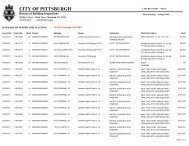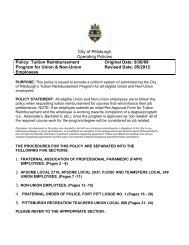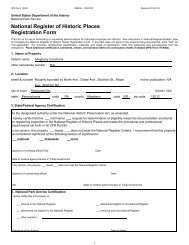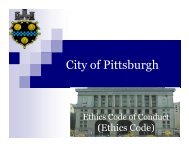east liberty station: realizing the potential - City of Pittsburgh
east liberty station: realizing the potential - City of Pittsburgh
east liberty station: realizing the potential - City of Pittsburgh
You also want an ePaper? Increase the reach of your titles
YUMPU automatically turns print PDFs into web optimized ePapers that Google loves.
capture to fund <strong>the</strong>se<br />
improvements. The recommended<br />
elTRID value capture strategy will<br />
guide investment in project specific<br />
infrastructure, district-wide improvements<br />
and maintenance.<br />
Ultimately, successful TOD requires<br />
good markets, good <strong>station</strong> areas<br />
and excellent coordination between<br />
numerous parties all dedicated to<br />
its success. With all <strong>of</strong> <strong>the</strong>se<br />
ingredients, <strong>the</strong> study area is<br />
uniquely positioned to capitalize on<br />
TOD opportunities. However as<br />
discussed, <strong>the</strong> current infrastructure<br />
and urban fabric remains a<br />
hindrance to dense, mixed-use<br />
development in <strong>the</strong> vicinity <strong>of</strong> East<br />
Liberty <strong>station</strong>. Uncertainty as to<br />
how <strong>the</strong>se improvements will be<br />
financed deters <strong>the</strong> development<br />
community from advancing projects<br />
despite improving market<br />
conditions.<br />
A financial strategy to address <strong>the</strong><br />
site specific and district-wide<br />
impediments to TOD is critical to<br />
unlocking <strong>the</strong> redevelopment<br />
<strong>potential</strong> in <strong>the</strong> elTRID study area.<br />
It is anticipated over $280 million <strong>of</strong><br />
mixed-use and residential<br />
development will occur within <strong>the</strong><br />
TRID Boundary over <strong>the</strong> 30 year<br />
timeframe. This includes known<br />
projects within <strong>the</strong> pipeline as well<br />
as sites that have been identified as<br />
<strong>potential</strong> redevelopment<br />
opportunities. At full build out, this<br />
new development is expected to<br />
create over $230 million <strong>of</strong> total<br />
assessed value.<br />
Approximately $125 million <strong>of</strong><br />
incremental assessed value would<br />
be created by <strong>the</strong> development<br />
program at <strong>the</strong> peak <strong>of</strong> <strong>the</strong> TRID<br />
value capture area. The newly<br />
created value represents a 20%<br />
increase over <strong>the</strong> base assessed<br />
value today. Within <strong>the</strong> half-mile<br />
study area, new incremental value<br />
created in <strong>the</strong> TRID Boundary would<br />
represent an approximately 33%<br />
increase in total assessed value<br />
after all value capture areas<br />
expired. Annual incremental real<br />
property tax revenue <strong>of</strong> $3.8 million<br />
would be generated by this increase<br />
in assessed value during <strong>the</strong> peak.<br />
Approximate $65 million <strong>of</strong><br />
incremental revenues would be<br />
generated by new projects within<br />
<strong>the</strong> TRID Boundary over 30 years<br />
by phasing implementation <strong>of</strong> <strong>the</strong><br />
value capture areas. A portion <strong>of</strong><br />
<strong>the</strong>se new revenues would be<br />
diverted to fund specific project<br />
infrastructure or district wide<br />
improvements as outlined in <strong>the</strong><br />
recommended elTRID<br />
comprehensive value capture<br />
strategy.<br />
Obviously <strong>the</strong> capture <strong>of</strong> TRID<br />
revenues within <strong>the</strong> proposed value<br />
capture areas represents taxes<br />
foregone by <strong>the</strong> local taxing bodies.<br />
Every dollar <strong>of</strong> this public<br />
investment will leverage at l<strong>east</strong><br />
six dollars <strong>of</strong> private investment.<br />
However, significant economic impacts<br />
are expected within <strong>the</strong> study area<br />
following implementation <strong>of</strong> <strong>the</strong> elTRID.<br />
Estimated benefits include private<br />
investment, job creation, retention <strong>of</strong><br />
existing jobs and o<strong>the</strong>r non-real<br />
property or income tax revenues/fees<br />
associated with area wide revitalization<br />
following transportation and<br />
infrastructure improvements.<br />
PROCESS<br />
The elTRID planning study was<br />
undertaken by a multi-disciplinary team<br />
led by GSP Consulting Corp (GSP), a<br />
<strong>Pittsburgh</strong>-based consulting firm that<br />
specializes in economic development<br />
strategies, development finance and<br />
government relations. GSP coordinated<br />
a comprehensive TRID financing<br />
strategy based upon viable market<br />
alternatives and community<br />
assessment. The firm also managed<br />
<strong>the</strong> efforts <strong>of</strong> <strong>the</strong> consultant team and<br />
schedule. Studio for Spatial Practice, a<br />
local architecture, urban design and<br />
planning firm, provided conceptual<br />
designs for planned or <strong>potential</strong> TOD in<br />
conjunction with infrastructure<br />
improvements. They also worked to<br />
facilitate public input into <strong>the</strong> planning<br />
process, including <strong>the</strong> production <strong>of</strong><br />
outreach and training materials.<br />
Fitzgerald & Halliday, Inc assessed<br />
transit, transportation and parking<br />
systems and identified improvements.<br />
Review <strong>of</strong> utility infrastructure was<br />
conducted by Civil and Environmental<br />
Consultants, Inc.<br />
11
















